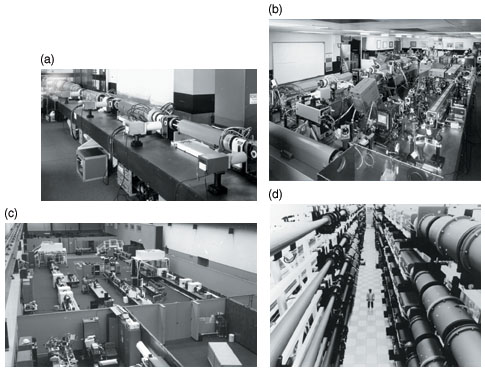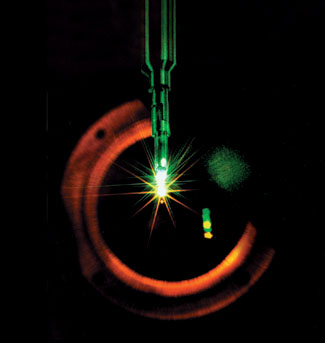Empowering Light
Historic Accomplishments in Laser Research
Excerpt...
In 1974, Livermore finished the one-beam, 10-joule Janus laser and used it to conduct the first fusion experiments at the Laboratory. It was used to demonstrate for the first time the thermonuclear reaction in laser-imploded deuterium–tritium fuel capsules. Starting in 1974, the two-beam Janus laser was used to gain a better understanding of laser–plasma physics and thermonuclear physics. It was also used to improve the LASNEX computer code, a hydrodynamics code developed in the 1970s for laser fusion predictions, which is still in use today.
The one-beam Cyclops was also completed in 1974. Its beamline was a prototype of the yet-to-be built Shiva laser.

CAPTION: From 1973 to 1977, the Laboratory built four laser systems: (a) the one-beam Cyclops; (b) the one- and two-beam Janus system, which is still in use; (c) the two-beam Argus; and (d) the 20-beam Shiva. Each new laser provided more power and better control over the target-irradiation conditions as well as produced higher temperatures and greater compression and density in the deuterium–tritium fuel than its predecessor.
Excerpt...
The 20-beam Shiva became the world’s most powerful laser in 1977, delivering 10.2 kilojoules of energy in less than a billionth of a second in its first full-power firing. In June 1979, Shiva compressed fusion fuel to a density of 50 to 100 times greater than its liquid density. Even more important, according to John Holzrichter, who was responsible for the laser and ICF programs at the time, Shiva proved once and for all that infrared laser light was too long a wavelength to reach fusion energy gain. Says Holzrichter, “The laser beam generates a dense plasma where it impinges on the target material. The laser light gives up its energy to the electrons in the plasma, which absorb the light. The rate at which that happens depends on the wavelength and the intensity. On Shiva, we were heating up electrons to incredible energies, but the targets were not performing well. We tried a lot of stuff to coax the electrons to transfer more of their energy to the target, with no success.”

CAPTION: This miniature “star” was created in the Nova laser target chamber as 300 trillion watts of power hit a 0.5-millimeter-diameter target capsule containing deuterium–tritium fuel.
Excerpt...
Ten times more powerful than Shiva, Nova became the world’s most powerful laser. In 1986, Nova produced the largest laser fusion yield to date—a record 11 trillion fusion neutrons. The following year, Nova compressed a fusion fuel target to about one-thirtieth of its original diameter, close to that needed for ignition and fusion gain. In 1996, one arm of Nova was reconfigured as a petawatt laser. (See S&TR, March 2000, The Amazing Power of the Pettawatt; December 1996, Crossing the Petawatt Threshold.) Record-setting laser shots produced pulses with more than 1.3 quadrillion watts, or 1.3 petawatts, of peak power. The laser pulse lasted less than 0.5 trillionth of a second—more than a thousand times shorter than shots typically produced by Nova’s 10 beams.
Now here is the kicker...
Excerpt...
When the United States ceased nuclear testing, laser facilities became even more important for defense research, and the portion of Nova shots dedicated to the weapons program increased considerably. Researchers using Nova continued obtaining high-energy-density data necessary to validate the computer codes used to model nuclear weapons physics.
SOURCE: Science &Technology Review
September 2002 Empowering Light -
Historic Accomplishments in Laser Research
Ten times more powerful than Shiva, Nova became the world’s most powerful laser. .....
Lots of PDF files Available in Public Domain
CERN is making Miniature Black Holes and LLNL is making Miniature Suns and beam Weapons...
Stay tuned for more...